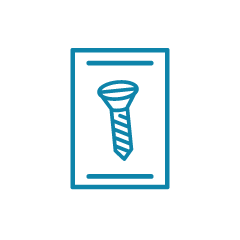A rivet works by being pushed through a hole of close diameter to the rivet and a special tool holds the central shaft with a ball at one end and pulls it through the inside of the small hollow tube, there by expanding the out side of the tube and pulling the two materials together. When the central shaft has pulled the materials together and expanded the tube the shaft reaches its limit of elasticity and snaps off.
The rivet is denoted by a number and then a series of letters followed by a number sequence. The first number represents the style e.g. 72 = Countersunk head, 73 = Truss head or Pan Head. Then the letters represent the body and shaft material i.e. STST which means stainless steel body and stainless steel shaft, and A for aluminium S for steel and M for Monel. The last set of numbers are the size and riveting length. The sizes are derived from the old imperial system so can take a little time to understand. First: the diameter number is derived from the number of 1/32nds of diameter I.e. 1/8 = 4/32, hence a number 4 rivet. Second: the length is derived from the number of 1/16ths of riveting thickness or draw, hence a draw thickness of 5/16 = 5. So we can see that a rivet denoted 73STST4-5 is a pan head rivet stainless body, stainless shaft 1/8 in diameter and a draw thickness of 5/16ÂÂ. In our metric system the number of the rivet is usually 1 greater than it's diameter in mm i.e. a 3mm diameter rivet is a number 4.
Beside those stated above there are also large truss head rivets (ASL) for rubber / canvas and sealed at one end rivets for water tightness (TA).
The body and shaft can be either of the same or different materials - Aluminium, Stainless Steel, Steel, Monel. Hence: STST = Stainless Steel body with Stainless Steel shaft AS = Aluminium body with Steel shaft AA = Aluminium body with Aluminium shaft MS = Monell Body with Steel shaft.
Used mainly for connecting two or more sheet metal components together, but other material such as rubber or canvas may be held. Monel rivets are often used in the Martine Industry due to it's excellent corrosion resistance. Tef-Gel can be used to separate the Stainless Steel or Monel material from Aluminium or Carbon product being riveted to avoid galvanic Corrosion.
Tools: Use designated Riveting Tools
Requirements: Correct sized drill required to drill hole prior
to pushing in rivet, special tool to pull up rivet like our
riveting
tool.
For Dimensions and ratings refer to our
Free gun with every full bucket of fischer V 300 T injection mortar purchased!
Anzor’s Sustainability Initiatives
New MBIE Building Product Information Requirements (BPIR) Legislation
To receive useful info and product updates add your details below

Request a copy of our Engineering & Marine, or Construction Wall Chart.

Click here to download a PDF of our Engineering Catalogue. This catalogue includes stainless fasteners and fittings, marine hardware and construction brackets.

Click here dot download a PDF of our Construction Catalogue. This catalogue includes stainless/galvanized fasteners and fittings, and construction brackets.